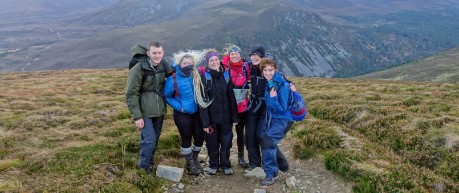Planning is a vital stage in getting the most out of your adventures in Scotlandís awesome winter mountains. But what IS planning?
Chances are it involves a lot more than you think. For many people planning means looking through a favourite website, guide book or map and picking out a hill or route that you fancy, check the weather forecast the night before, pack your rucksack and youíre set. Well not quite! Think people, conditions, route choice, terrain - and always have at least one alternative.
Watch our videos on YouTube and read on below to find out more.
Start with yourself and the people youíre going with.
What experience does everyone have? How fit are they? What about their kit and their skills?
The answers to these questions will have a massive bearing on where and when you chose to go. And think of all the group in this, not just the fittest and best.
Skills and experience are best gained gradually: work up to difficulty in stages, donít just go straight for the hardest routes until youíve tested yourself and learned lessons on easier challenges. It may be you decide that you or your party would benefit from some training in advance of any trips. Or you might think about joining a club to benefit from othersí experience and support.

When youíre choosing a destination or a route it's best to study the whole route on the map - donít just look at the start point and the distance. Take note of the terrain youíll encounter and the steepness of the slopes (remembering that slopes of 30 degrees and above are where avalanches may occur). Check any key points in the route where you might encounter hazards, such as river crossings, scrambling sections or those steeper slopes.
Work out approximate timings, not just for the whole route, but also for reaching key points along the route. This will help with navigation and will be invaluable if you need a cut-off time for getting back to your start point.
Remember: travel in winter will be much slower than in summer because of weather and underfoot conditions.

The weather in winter can be challenging. Simply checking the TV weather forecast the night before isn't enough. You know where youíre going so use a good mountain weather forecast service such as the Mountain Weather Information Service (MWIS) or the Met Office.
The Scottish Avalanche Information Service blog will help you study the weather and snow conditions in that area in the weeks and days before your trip. That allows you to build up a picture of what conditions will be like and what effect the weather expected on the day will have.
And, of course, donít forget that final check for the day of your trip.

It's recommended that you have at least one alternative plan. Last minute changes of weather or other circumstances can very easily make your main plan impracticable, so rather than abandon the whole day, have something up your sleeve in reserve Ė but make sure youíve planned that properly too!
Finally. Remember itís okay to change plans if it makes sense to do so. Sometimes saying no and turning round is the best decision.

